Economics & Healthcare: Funding Models & Casemix Systems Essay
VerifiedAdded on 2023/06/15
|12
|3434
|376
Essay
AI Summary
This essay explores the application of various economic concepts, funding frameworks, and casemix-based management information systems within the healthcare sector, emphasizing the pivotal role of nurse managers in ensuring clinical and cost-effective healthcare. It explains economic concepts like opportunity cost, cost-effectiveness analysis, technical efficiency, and allocative efficiency, providing examples from practice. The essay also discusses activity-based funding (ABF) as an incentive to enhance accountability, drive efficiency, and improve access to care, identifying health service provision activities not currently funded under ABF. Furthermore, it examines casemix-based management information systems, highlighting the clinical and financial data they provide for nurse managers in decision-making related to staff planning and patient care, while also addressing concerns regarding the quality of care under casemix-based management.
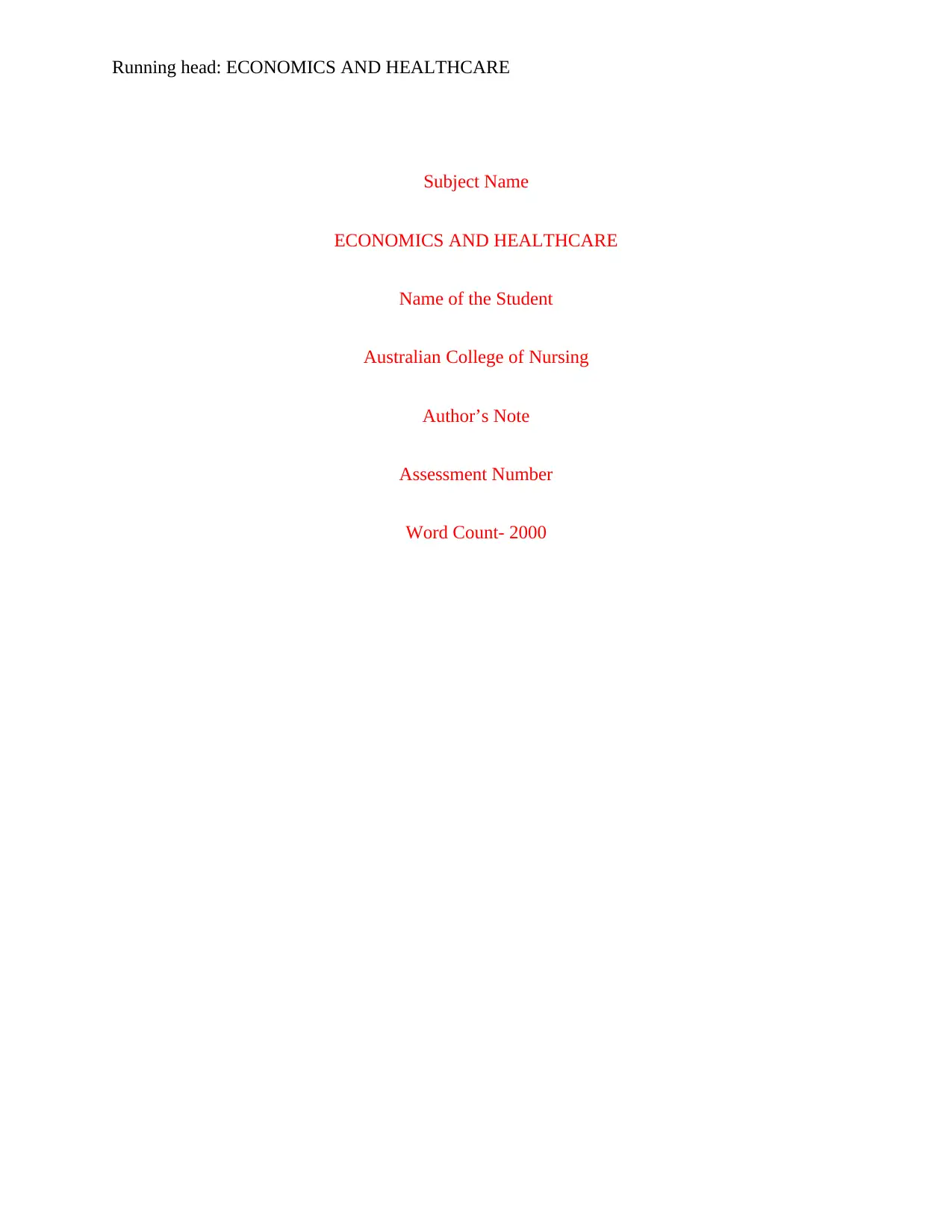
Running head: ECONOMICS AND HEALTHCARE
Subject Name
ECONOMICS AND HEALTHCARE
Name of the Student
Australian College of Nursing
Author’s Note
Assessment Number
Word Count- 2000
Subject Name
ECONOMICS AND HEALTHCARE
Name of the Student
Australian College of Nursing
Author’s Note
Assessment Number
Word Count- 2000
Paraphrase This Document
Need a fresh take? Get an instant paraphrase of this document with our AI Paraphraser
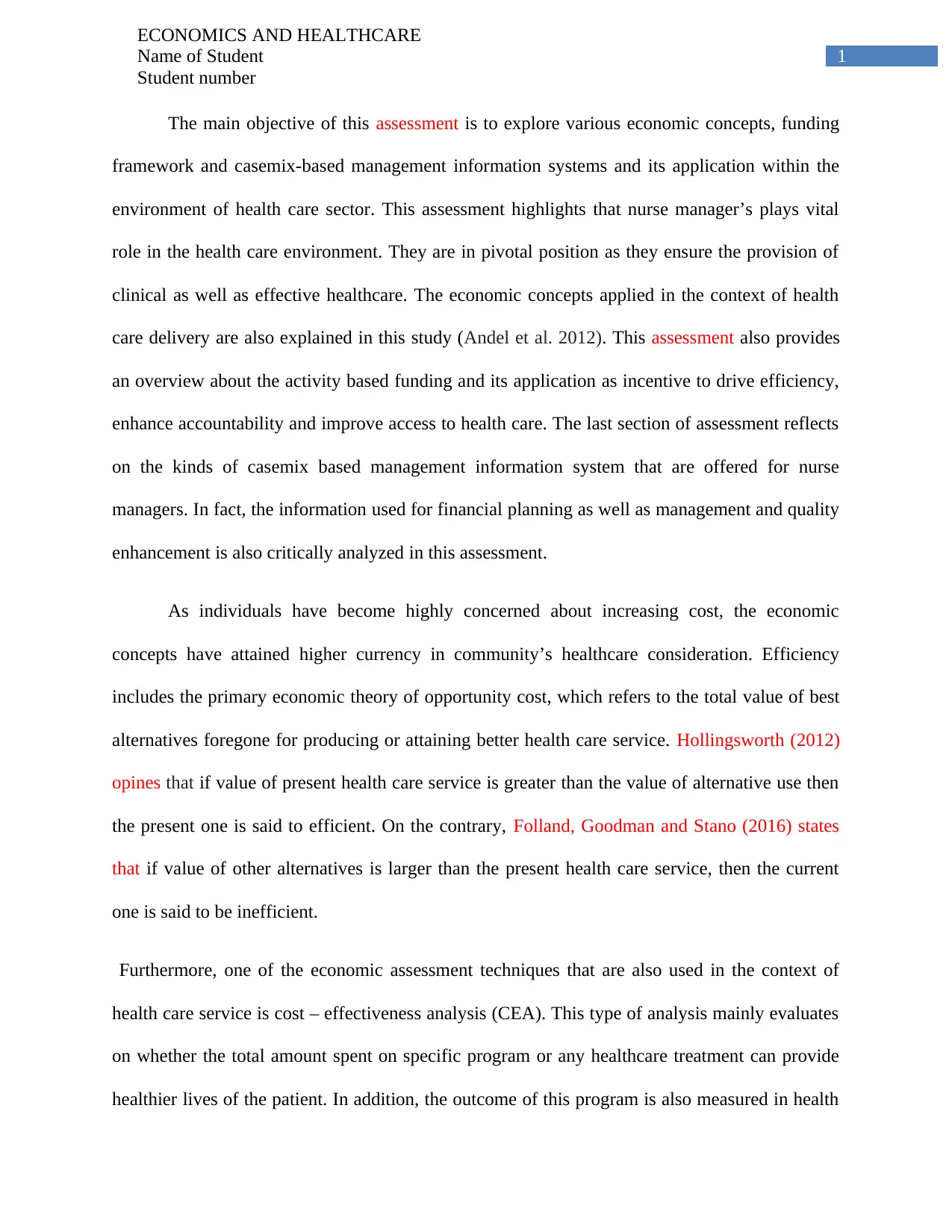
1
ECONOMICS AND HEALTHCARE
Name of Student
Student number
The main objective of this assessment is to explore various economic concepts, funding
framework and casemix-based management information systems and its application within the
environment of health care sector. This assessment highlights that nurse manager’s plays vital
role in the health care environment. They are in pivotal position as they ensure the provision of
clinical as well as effective healthcare. The economic concepts applied in the context of health
care delivery are also explained in this study (Andel et al. 2012). This assessment also provides
an overview about the activity based funding and its application as incentive to drive efficiency,
enhance accountability and improve access to health care. The last section of assessment reflects
on the kinds of casemix based management information system that are offered for nurse
managers. In fact, the information used for financial planning as well as management and quality
enhancement is also critically analyzed in this assessment.
As individuals have become highly concerned about increasing cost, the economic
concepts have attained higher currency in community’s healthcare consideration. Efficiency
includes the primary economic theory of opportunity cost, which refers to the total value of best
alternatives foregone for producing or attaining better health care service. Hollingsworth (2012)
opines that if value of present health care service is greater than the value of alternative use then
the present one is said to efficient. On the contrary, Folland, Goodman and Stano (2016) states
that if value of other alternatives is larger than the present health care service, then the current
one is said to be inefficient.
Furthermore, one of the economic assessment techniques that are also used in the context of
health care service is cost – effectiveness analysis (CEA). This type of analysis mainly evaluates
on whether the total amount spent on specific program or any healthcare treatment can provide
healthier lives of the patient. In addition, the outcome of this program is also measured in health
ECONOMICS AND HEALTHCARE
Name of Student
Student number
The main objective of this assessment is to explore various economic concepts, funding
framework and casemix-based management information systems and its application within the
environment of health care sector. This assessment highlights that nurse manager’s plays vital
role in the health care environment. They are in pivotal position as they ensure the provision of
clinical as well as effective healthcare. The economic concepts applied in the context of health
care delivery are also explained in this study (Andel et al. 2012). This assessment also provides
an overview about the activity based funding and its application as incentive to drive efficiency,
enhance accountability and improve access to health care. The last section of assessment reflects
on the kinds of casemix based management information system that are offered for nurse
managers. In fact, the information used for financial planning as well as management and quality
enhancement is also critically analyzed in this assessment.
As individuals have become highly concerned about increasing cost, the economic
concepts have attained higher currency in community’s healthcare consideration. Efficiency
includes the primary economic theory of opportunity cost, which refers to the total value of best
alternatives foregone for producing or attaining better health care service. Hollingsworth (2012)
opines that if value of present health care service is greater than the value of alternative use then
the present one is said to efficient. On the contrary, Folland, Goodman and Stano (2016) states
that if value of other alternatives is larger than the present health care service, then the current
one is said to be inefficient.
Furthermore, one of the economic assessment techniques that are also used in the context of
health care service is cost – effectiveness analysis (CEA). This type of analysis mainly evaluates
on whether the total amount spent on specific program or any healthcare treatment can provide
healthier lives of the patient. In addition, the outcome of this program is also measured in health
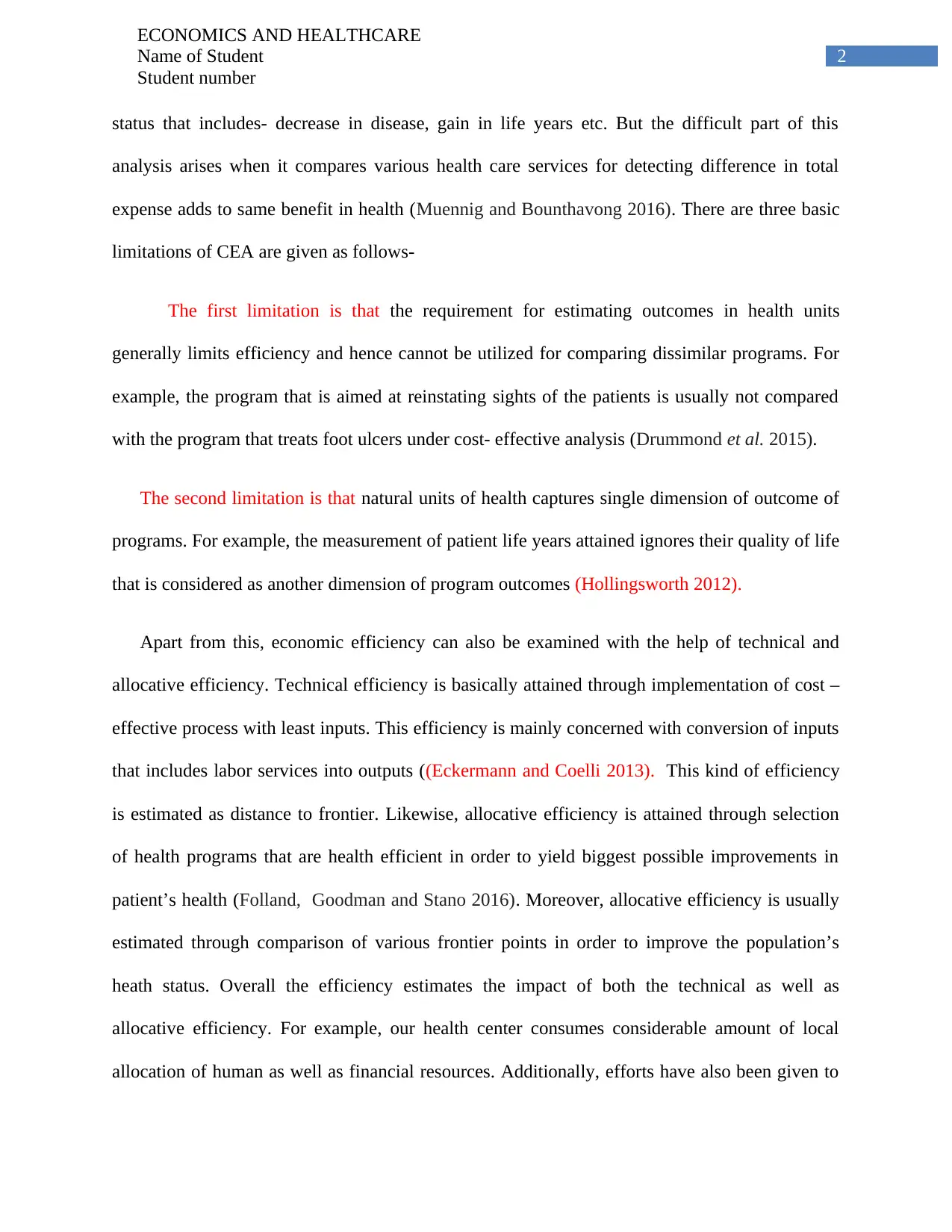
2
ECONOMICS AND HEALTHCARE
Name of Student
Student number
status that includes- decrease in disease, gain in life years etc. But the difficult part of this
analysis arises when it compares various health care services for detecting difference in total
expense adds to same benefit in health (Muennig and Bounthavong 2016). There are three basic
limitations of CEA are given as follows-
The first limitation is that the requirement for estimating outcomes in health units
generally limits efficiency and hence cannot be utilized for comparing dissimilar programs. For
example, the program that is aimed at reinstating sights of the patients is usually not compared
with the program that treats foot ulcers under cost- effective analysis (Drummond et al. 2015).
The second limitation is that natural units of health captures single dimension of outcome of
programs. For example, the measurement of patient life years attained ignores their quality of life
that is considered as another dimension of program outcomes (Hollingsworth 2012).
Apart from this, economic efficiency can also be examined with the help of technical and
allocative efficiency. Technical efficiency is basically attained through implementation of cost –
effective process with least inputs. This efficiency is mainly concerned with conversion of inputs
that includes labor services into outputs ((Eckermann and Coelli 2013). This kind of efficiency
is estimated as distance to frontier. Likewise, allocative efficiency is attained through selection
of health programs that are health efficient in order to yield biggest possible improvements in
patient’s health (Folland, Goodman and Stano 2016). Moreover, allocative efficiency is usually
estimated through comparison of various frontier points in order to improve the population’s
heath status. Overall the efficiency estimates the impact of both the technical as well as
allocative efficiency. For example, our health center consumes considerable amount of local
allocation of human as well as financial resources. Additionally, efforts have also been given to
ECONOMICS AND HEALTHCARE
Name of Student
Student number
status that includes- decrease in disease, gain in life years etc. But the difficult part of this
analysis arises when it compares various health care services for detecting difference in total
expense adds to same benefit in health (Muennig and Bounthavong 2016). There are three basic
limitations of CEA are given as follows-
The first limitation is that the requirement for estimating outcomes in health units
generally limits efficiency and hence cannot be utilized for comparing dissimilar programs. For
example, the program that is aimed at reinstating sights of the patients is usually not compared
with the program that treats foot ulcers under cost- effective analysis (Drummond et al. 2015).
The second limitation is that natural units of health captures single dimension of outcome of
programs. For example, the measurement of patient life years attained ignores their quality of life
that is considered as another dimension of program outcomes (Hollingsworth 2012).
Apart from this, economic efficiency can also be examined with the help of technical and
allocative efficiency. Technical efficiency is basically attained through implementation of cost –
effective process with least inputs. This efficiency is mainly concerned with conversion of inputs
that includes labor services into outputs ((Eckermann and Coelli 2013). This kind of efficiency
is estimated as distance to frontier. Likewise, allocative efficiency is attained through selection
of health programs that are health efficient in order to yield biggest possible improvements in
patient’s health (Folland, Goodman and Stano 2016). Moreover, allocative efficiency is usually
estimated through comparison of various frontier points in order to improve the population’s
heath status. Overall the efficiency estimates the impact of both the technical as well as
allocative efficiency. For example, our health center consumes considerable amount of local
allocation of human as well as financial resources. Additionally, efforts have also been given to
⊘ This is a preview!⊘
Do you want full access?
Subscribe today to unlock all pages.

Trusted by 1+ million students worldwide
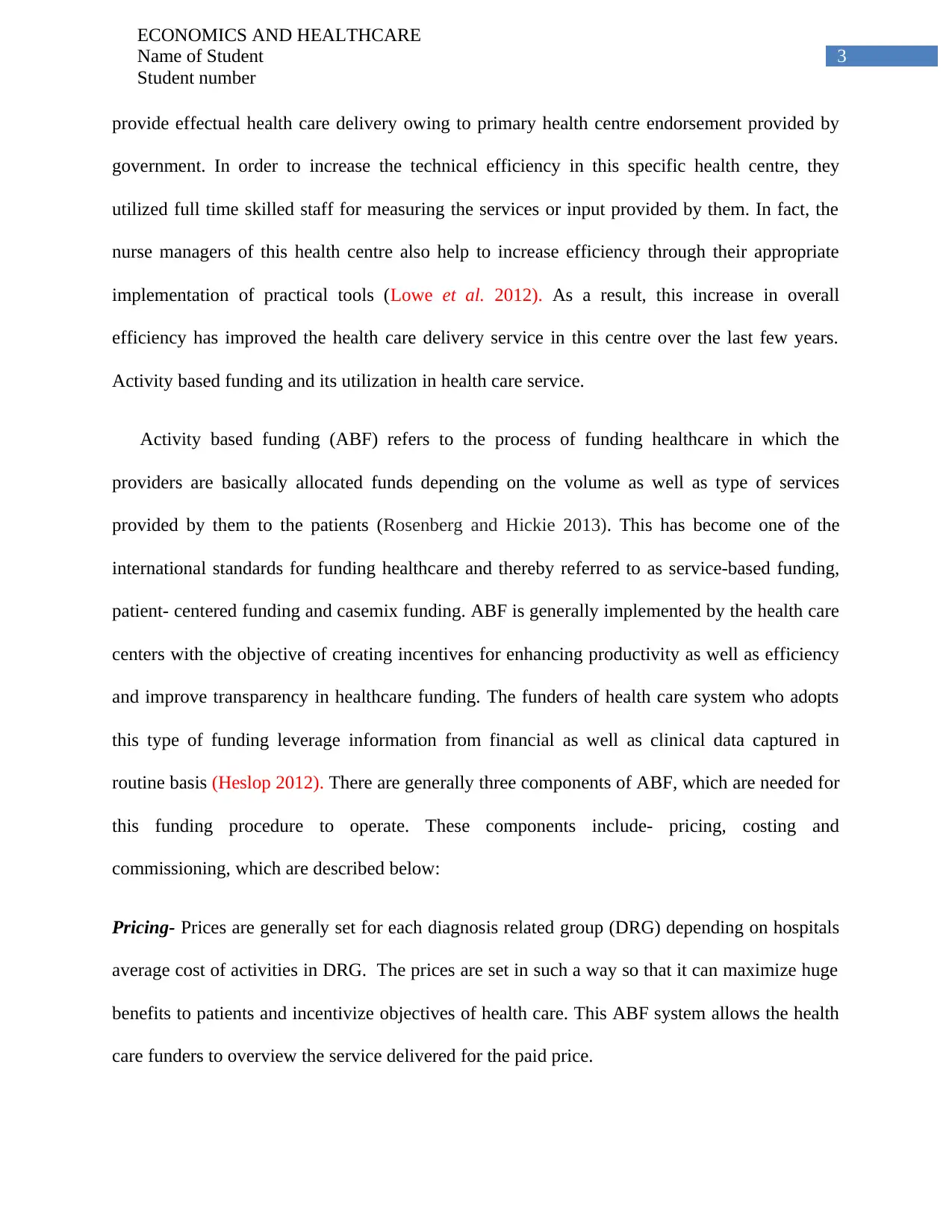
3
ECONOMICS AND HEALTHCARE
Name of Student
Student number
provide effectual health care delivery owing to primary health centre endorsement provided by
government. In order to increase the technical efficiency in this specific health centre, they
utilized full time skilled staff for measuring the services or input provided by them. In fact, the
nurse managers of this health centre also help to increase efficiency through their appropriate
implementation of practical tools (Lowe et al. 2012). As a result, this increase in overall
efficiency has improved the health care delivery service in this centre over the last few years.
Activity based funding and its utilization in health care service.
Activity based funding (ABF) refers to the process of funding healthcare in which the
providers are basically allocated funds depending on the volume as well as type of services
provided by them to the patients (Rosenberg and Hickie 2013). This has become one of the
international standards for funding healthcare and thereby referred to as service-based funding,
patient- centered funding and casemix funding. ABF is generally implemented by the health care
centers with the objective of creating incentives for enhancing productivity as well as efficiency
and improve transparency in healthcare funding. The funders of health care system who adopts
this type of funding leverage information from financial as well as clinical data captured in
routine basis (Heslop 2012). There are generally three components of ABF, which are needed for
this funding procedure to operate. These components include- pricing, costing and
commissioning, which are described below:
Pricing- Prices are generally set for each diagnosis related group (DRG) depending on hospitals
average cost of activities in DRG. The prices are set in such a way so that it can maximize huge
benefits to patients and incentivize objectives of health care. This ABF system allows the health
care funders to overview the service delivered for the paid price.
ECONOMICS AND HEALTHCARE
Name of Student
Student number
provide effectual health care delivery owing to primary health centre endorsement provided by
government. In order to increase the technical efficiency in this specific health centre, they
utilized full time skilled staff for measuring the services or input provided by them. In fact, the
nurse managers of this health centre also help to increase efficiency through their appropriate
implementation of practical tools (Lowe et al. 2012). As a result, this increase in overall
efficiency has improved the health care delivery service in this centre over the last few years.
Activity based funding and its utilization in health care service.
Activity based funding (ABF) refers to the process of funding healthcare in which the
providers are basically allocated funds depending on the volume as well as type of services
provided by them to the patients (Rosenberg and Hickie 2013). This has become one of the
international standards for funding healthcare and thereby referred to as service-based funding,
patient- centered funding and casemix funding. ABF is generally implemented by the health care
centers with the objective of creating incentives for enhancing productivity as well as efficiency
and improve transparency in healthcare funding. The funders of health care system who adopts
this type of funding leverage information from financial as well as clinical data captured in
routine basis (Heslop 2012). There are generally three components of ABF, which are needed for
this funding procedure to operate. These components include- pricing, costing and
commissioning, which are described below:
Pricing- Prices are generally set for each diagnosis related group (DRG) depending on hospitals
average cost of activities in DRG. The prices are set in such a way so that it can maximize huge
benefits to patients and incentivize objectives of health care. This ABF system allows the health
care funders to overview the service delivered for the paid price.
Paraphrase This Document
Need a fresh take? Get an instant paraphrase of this document with our AI Paraphraser
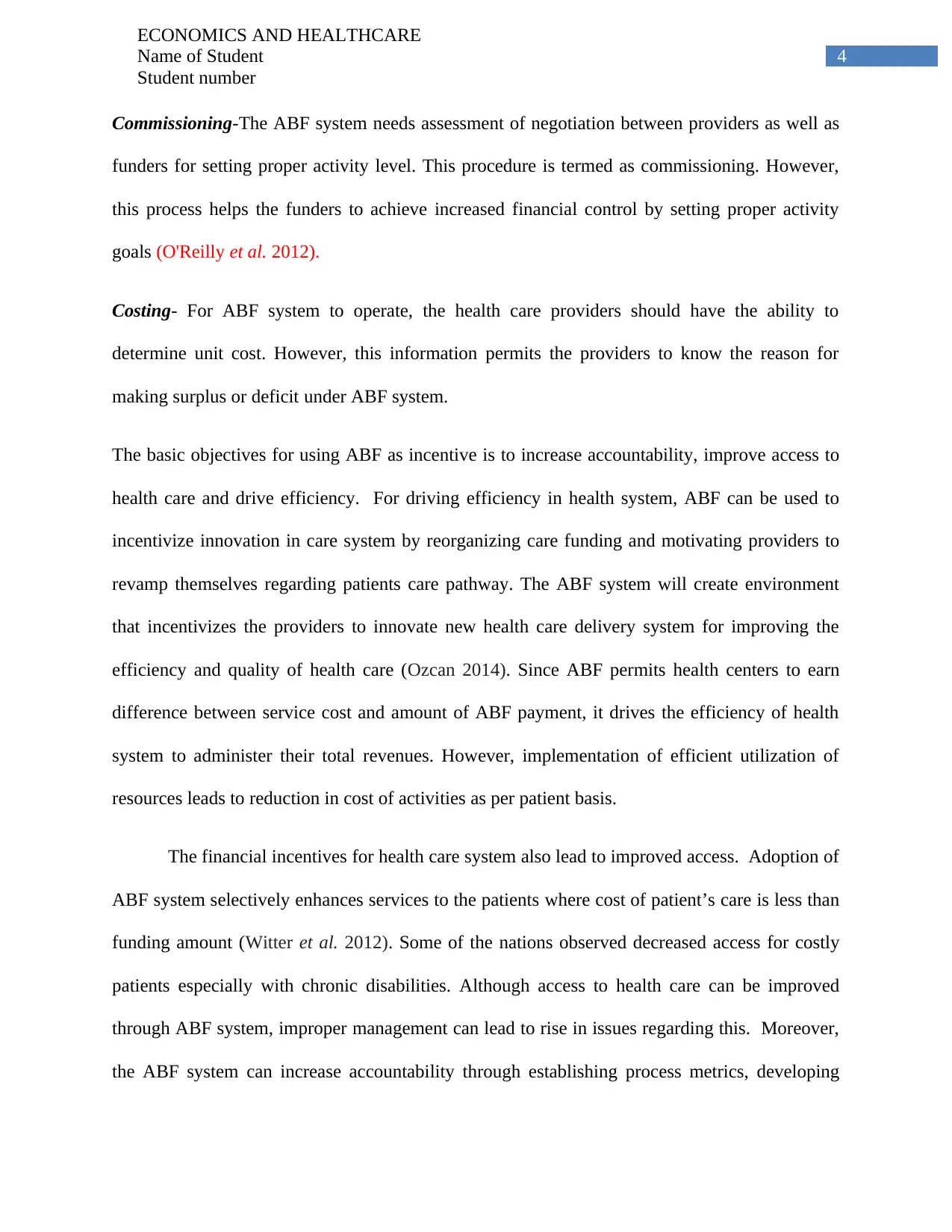
4
ECONOMICS AND HEALTHCARE
Name of Student
Student number
Commissioning-The ABF system needs assessment of negotiation between providers as well as
funders for setting proper activity level. This procedure is termed as commissioning. However,
this process helps the funders to achieve increased financial control by setting proper activity
goals (O'Reilly et al. 2012).
Costing- For ABF system to operate, the health care providers should have the ability to
determine unit cost. However, this information permits the providers to know the reason for
making surplus or deficit under ABF system.
The basic objectives for using ABF as incentive is to increase accountability, improve access to
health care and drive efficiency. For driving efficiency in health system, ABF can be used to
incentivize innovation in care system by reorganizing care funding and motivating providers to
revamp themselves regarding patients care pathway. The ABF system will create environment
that incentivizes the providers to innovate new health care delivery system for improving the
efficiency and quality of health care (Ozcan 2014). Since ABF permits health centers to earn
difference between service cost and amount of ABF payment, it drives the efficiency of health
system to administer their total revenues. However, implementation of efficient utilization of
resources leads to reduction in cost of activities as per patient basis.
The financial incentives for health care system also lead to improved access. Adoption of
ABF system selectively enhances services to the patients where cost of patient’s care is less than
funding amount (Witter et al. 2012). Some of the nations observed decreased access for costly
patients especially with chronic disabilities. Although access to health care can be improved
through ABF system, improper management can lead to rise in issues regarding this. Moreover,
the ABF system can increase accountability through establishing process metrics, developing
ECONOMICS AND HEALTHCARE
Name of Student
Student number
Commissioning-The ABF system needs assessment of negotiation between providers as well as
funders for setting proper activity level. This procedure is termed as commissioning. However,
this process helps the funders to achieve increased financial control by setting proper activity
goals (O'Reilly et al. 2012).
Costing- For ABF system to operate, the health care providers should have the ability to
determine unit cost. However, this information permits the providers to know the reason for
making surplus or deficit under ABF system.
The basic objectives for using ABF as incentive is to increase accountability, improve access to
health care and drive efficiency. For driving efficiency in health system, ABF can be used to
incentivize innovation in care system by reorganizing care funding and motivating providers to
revamp themselves regarding patients care pathway. The ABF system will create environment
that incentivizes the providers to innovate new health care delivery system for improving the
efficiency and quality of health care (Ozcan 2014). Since ABF permits health centers to earn
difference between service cost and amount of ABF payment, it drives the efficiency of health
system to administer their total revenues. However, implementation of efficient utilization of
resources leads to reduction in cost of activities as per patient basis.
The financial incentives for health care system also lead to improved access. Adoption of
ABF system selectively enhances services to the patients where cost of patient’s care is less than
funding amount (Witter et al. 2012). Some of the nations observed decreased access for costly
patients especially with chronic disabilities. Although access to health care can be improved
through ABF system, improper management can lead to rise in issues regarding this. Moreover,
the ABF system can increase accountability through establishing process metrics, developing
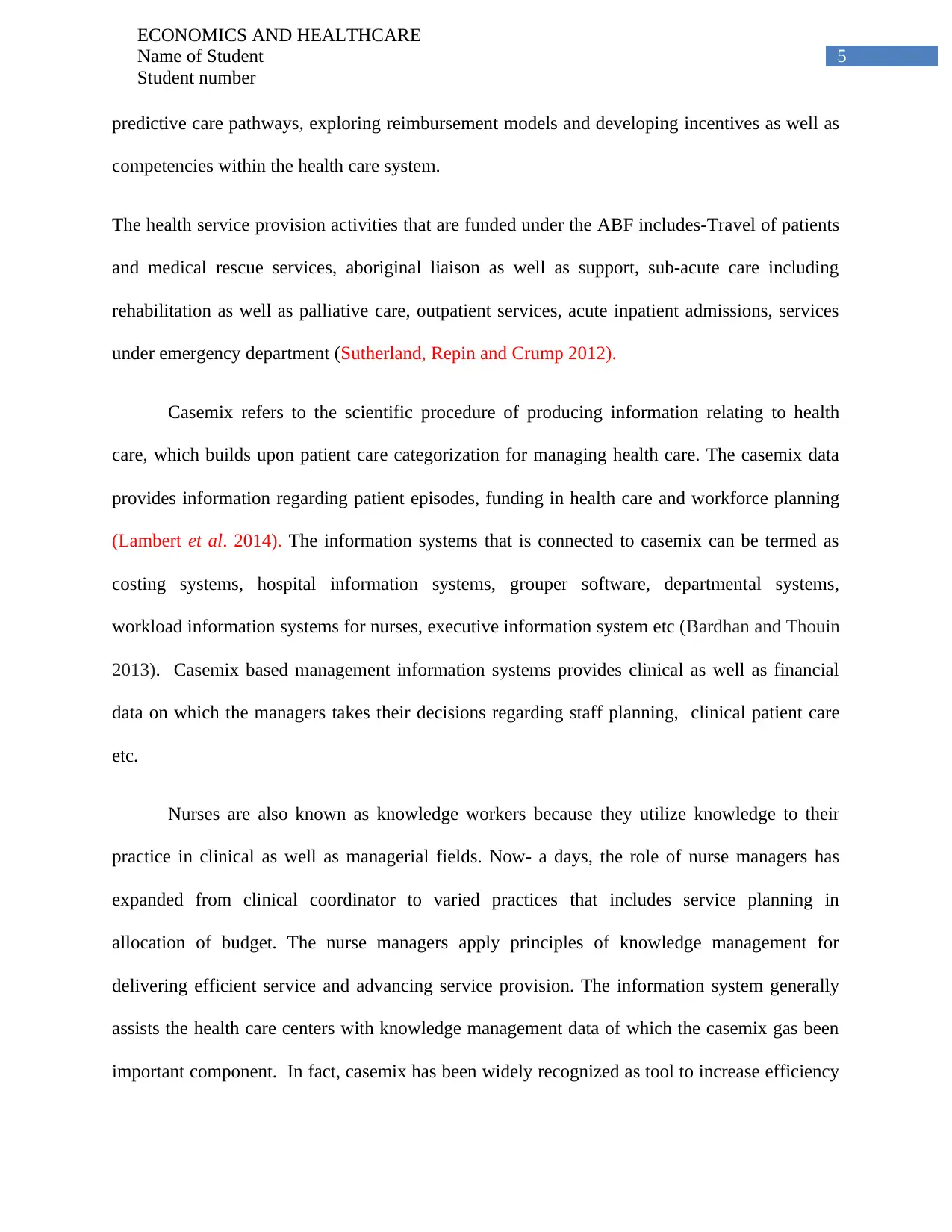
5
ECONOMICS AND HEALTHCARE
Name of Student
Student number
predictive care pathways, exploring reimbursement models and developing incentives as well as
competencies within the health care system.
The health service provision activities that are funded under the ABF includes-Travel of patients
and medical rescue services, aboriginal liaison as well as support, sub-acute care including
rehabilitation as well as palliative care, outpatient services, acute inpatient admissions, services
under emergency department (Sutherland, Repin and Crump 2012).
Casemix refers to the scientific procedure of producing information relating to health
care, which builds upon patient care categorization for managing health care. The casemix data
provides information regarding patient episodes, funding in health care and workforce planning
(Lambert et al. 2014). The information systems that is connected to casemix can be termed as
costing systems, hospital information systems, grouper software, departmental systems,
workload information systems for nurses, executive information system etc (Bardhan and Thouin
2013). Casemix based management information systems provides clinical as well as financial
data on which the managers takes their decisions regarding staff planning, clinical patient care
etc.
Nurses are also known as knowledge workers because they utilize knowledge to their
practice in clinical as well as managerial fields. Now- a days, the role of nurse managers has
expanded from clinical coordinator to varied practices that includes service planning in
allocation of budget. The nurse managers apply principles of knowledge management for
delivering efficient service and advancing service provision. The information system generally
assists the health care centers with knowledge management data of which the casemix gas been
important component. In fact, casemix has been widely recognized as tool to increase efficiency
ECONOMICS AND HEALTHCARE
Name of Student
Student number
predictive care pathways, exploring reimbursement models and developing incentives as well as
competencies within the health care system.
The health service provision activities that are funded under the ABF includes-Travel of patients
and medical rescue services, aboriginal liaison as well as support, sub-acute care including
rehabilitation as well as palliative care, outpatient services, acute inpatient admissions, services
under emergency department (Sutherland, Repin and Crump 2012).
Casemix refers to the scientific procedure of producing information relating to health
care, which builds upon patient care categorization for managing health care. The casemix data
provides information regarding patient episodes, funding in health care and workforce planning
(Lambert et al. 2014). The information systems that is connected to casemix can be termed as
costing systems, hospital information systems, grouper software, departmental systems,
workload information systems for nurses, executive information system etc (Bardhan and Thouin
2013). Casemix based management information systems provides clinical as well as financial
data on which the managers takes their decisions regarding staff planning, clinical patient care
etc.
Nurses are also known as knowledge workers because they utilize knowledge to their
practice in clinical as well as managerial fields. Now- a days, the role of nurse managers has
expanded from clinical coordinator to varied practices that includes service planning in
allocation of budget. The nurse managers apply principles of knowledge management for
delivering efficient service and advancing service provision. The information system generally
assists the health care centers with knowledge management data of which the casemix gas been
important component. In fact, casemix has been widely recognized as tool to increase efficiency
⊘ This is a preview!⊘
Do you want full access?
Subscribe today to unlock all pages.

Trusted by 1+ million students worldwide
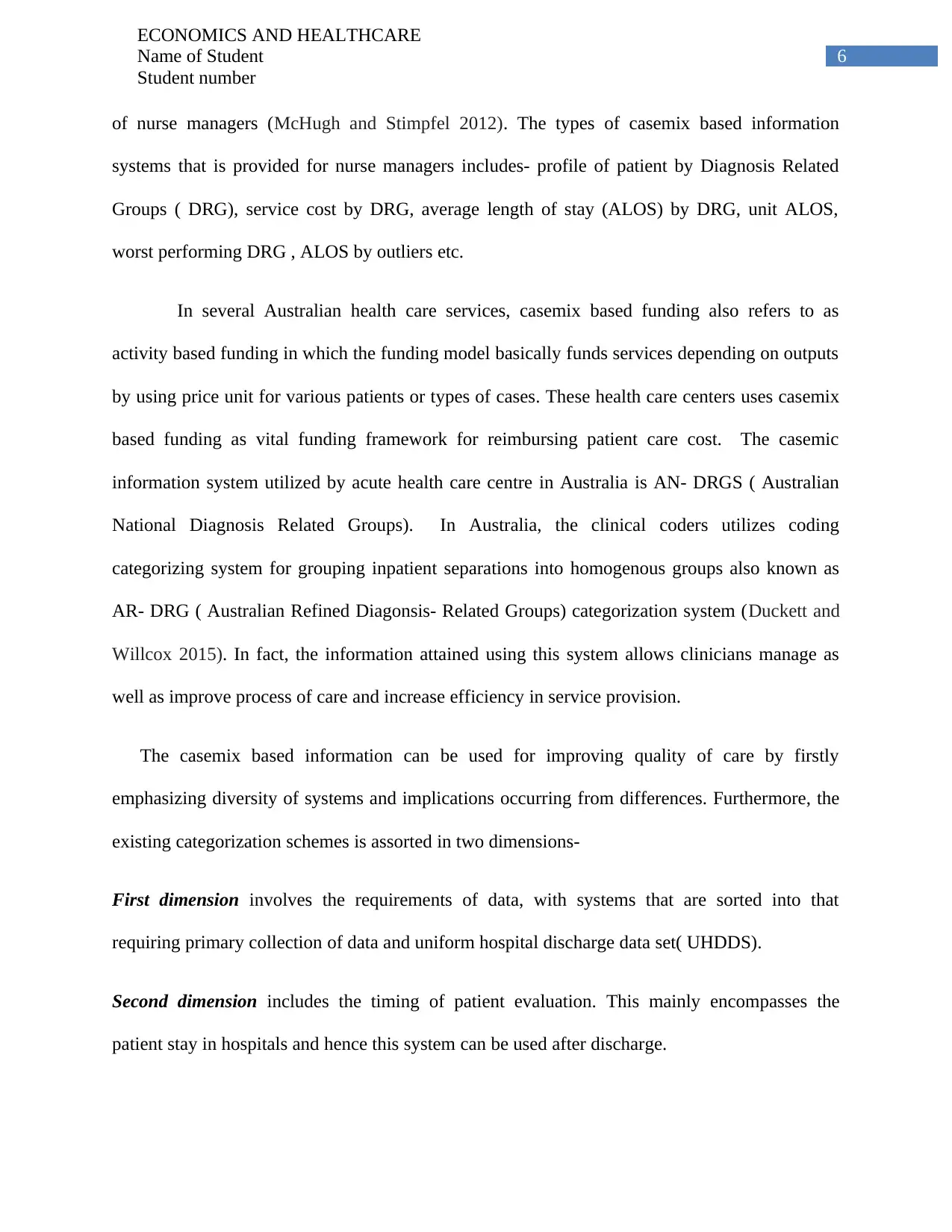
6
ECONOMICS AND HEALTHCARE
Name of Student
Student number
of nurse managers (McHugh and Stimpfel 2012). The types of casemix based information
systems that is provided for nurse managers includes- profile of patient by Diagnosis Related
Groups ( DRG), service cost by DRG, average length of stay (ALOS) by DRG, unit ALOS,
worst performing DRG , ALOS by outliers etc.
In several Australian health care services, casemix based funding also refers to as
activity based funding in which the funding model basically funds services depending on outputs
by using price unit for various patients or types of cases. These health care centers uses casemix
based funding as vital funding framework for reimbursing patient care cost. The casemic
information system utilized by acute health care centre in Australia is AN- DRGS ( Australian
National Diagnosis Related Groups). In Australia, the clinical coders utilizes coding
categorizing system for grouping inpatient separations into homogenous groups also known as
AR- DRG ( Australian Refined Diagonsis- Related Groups) categorization system (Duckett and
Willcox 2015). In fact, the information attained using this system allows clinicians manage as
well as improve process of care and increase efficiency in service provision.
The casemix based information can be used for improving quality of care by firstly
emphasizing diversity of systems and implications occurring from differences. Furthermore, the
existing categorization schemes is assorted in two dimensions-
First dimension involves the requirements of data, with systems that are sorted into that
requiring primary collection of data and uniform hospital discharge data set( UHDDS).
Second dimension includes the timing of patient evaluation. This mainly encompasses the
patient stay in hospitals and hence this system can be used after discharge.
ECONOMICS AND HEALTHCARE
Name of Student
Student number
of nurse managers (McHugh and Stimpfel 2012). The types of casemix based information
systems that is provided for nurse managers includes- profile of patient by Diagnosis Related
Groups ( DRG), service cost by DRG, average length of stay (ALOS) by DRG, unit ALOS,
worst performing DRG , ALOS by outliers etc.
In several Australian health care services, casemix based funding also refers to as
activity based funding in which the funding model basically funds services depending on outputs
by using price unit for various patients or types of cases. These health care centers uses casemix
based funding as vital funding framework for reimbursing patient care cost. The casemic
information system utilized by acute health care centre in Australia is AN- DRGS ( Australian
National Diagnosis Related Groups). In Australia, the clinical coders utilizes coding
categorizing system for grouping inpatient separations into homogenous groups also known as
AR- DRG ( Australian Refined Diagonsis- Related Groups) categorization system (Duckett and
Willcox 2015). In fact, the information attained using this system allows clinicians manage as
well as improve process of care and increase efficiency in service provision.
The casemix based information can be used for improving quality of care by firstly
emphasizing diversity of systems and implications occurring from differences. Furthermore, the
existing categorization schemes is assorted in two dimensions-
First dimension involves the requirements of data, with systems that are sorted into that
requiring primary collection of data and uniform hospital discharge data set( UHDDS).
Second dimension includes the timing of patient evaluation. This mainly encompasses the
patient stay in hospitals and hence this system can be used after discharge.
Paraphrase This Document
Need a fresh take? Get an instant paraphrase of this document with our AI Paraphraser
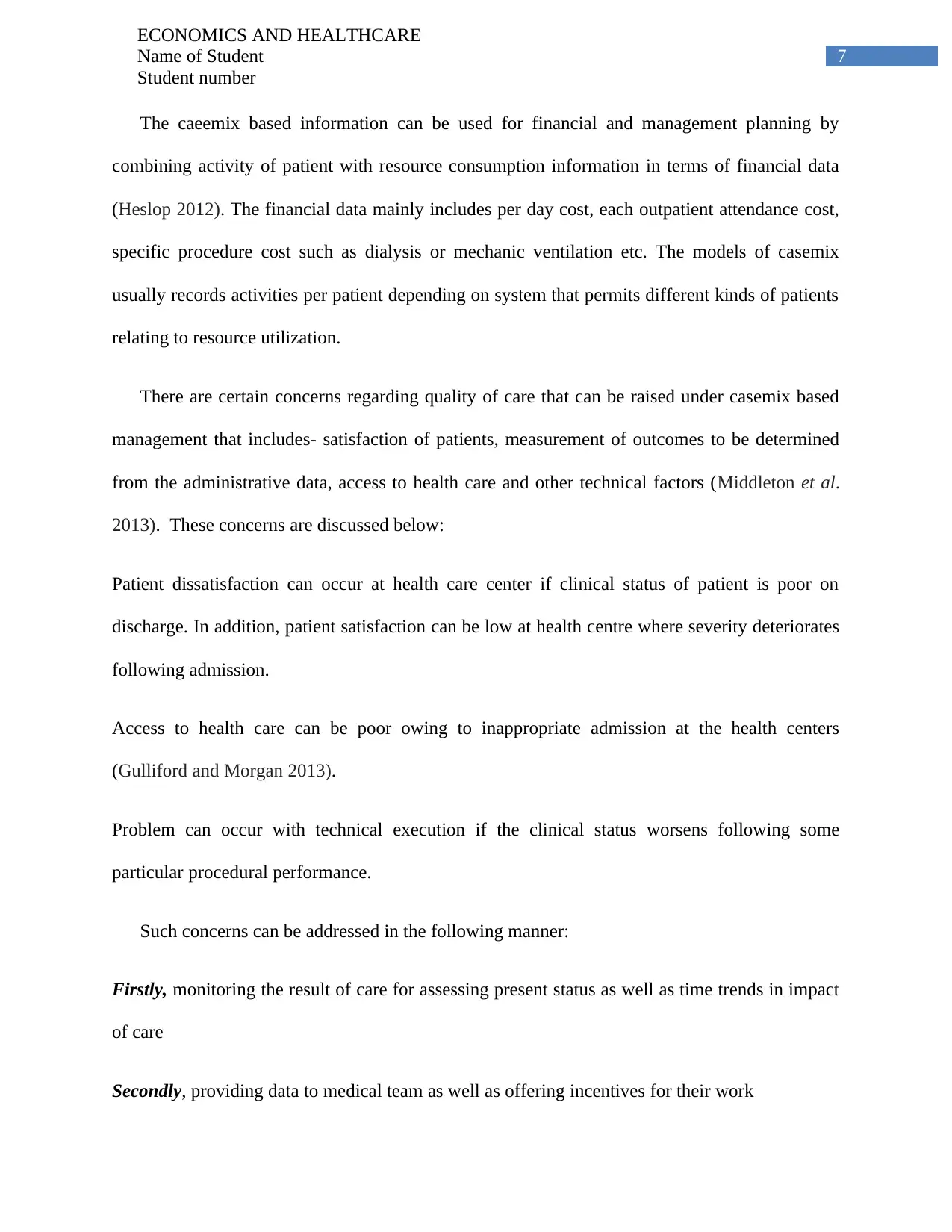
7
ECONOMICS AND HEALTHCARE
Name of Student
Student number
The caeemix based information can be used for financial and management planning by
combining activity of patient with resource consumption information in terms of financial data
(Heslop 2012). The financial data mainly includes per day cost, each outpatient attendance cost,
specific procedure cost such as dialysis or mechanic ventilation etc. The models of casemix
usually records activities per patient depending on system that permits different kinds of patients
relating to resource utilization.
There are certain concerns regarding quality of care that can be raised under casemix based
management that includes- satisfaction of patients, measurement of outcomes to be determined
from the administrative data, access to health care and other technical factors (Middleton et al.
2013). These concerns are discussed below:
Patient dissatisfaction can occur at health care center if clinical status of patient is poor on
discharge. In addition, patient satisfaction can be low at health centre where severity deteriorates
following admission.
Access to health care can be poor owing to inappropriate admission at the health centers
(Gulliford and Morgan 2013).
Problem can occur with technical execution if the clinical status worsens following some
particular procedural performance.
Such concerns can be addressed in the following manner:
Firstly, monitoring the result of care for assessing present status as well as time trends in impact
of care
Secondly, providing data to medical team as well as offering incentives for their work
ECONOMICS AND HEALTHCARE
Name of Student
Student number
The caeemix based information can be used for financial and management planning by
combining activity of patient with resource consumption information in terms of financial data
(Heslop 2012). The financial data mainly includes per day cost, each outpatient attendance cost,
specific procedure cost such as dialysis or mechanic ventilation etc. The models of casemix
usually records activities per patient depending on system that permits different kinds of patients
relating to resource utilization.
There are certain concerns regarding quality of care that can be raised under casemix based
management that includes- satisfaction of patients, measurement of outcomes to be determined
from the administrative data, access to health care and other technical factors (Middleton et al.
2013). These concerns are discussed below:
Patient dissatisfaction can occur at health care center if clinical status of patient is poor on
discharge. In addition, patient satisfaction can be low at health centre where severity deteriorates
following admission.
Access to health care can be poor owing to inappropriate admission at the health centers
(Gulliford and Morgan 2013).
Problem can occur with technical execution if the clinical status worsens following some
particular procedural performance.
Such concerns can be addressed in the following manner:
Firstly, monitoring the result of care for assessing present status as well as time trends in impact
of care
Secondly, providing data to medical team as well as offering incentives for their work
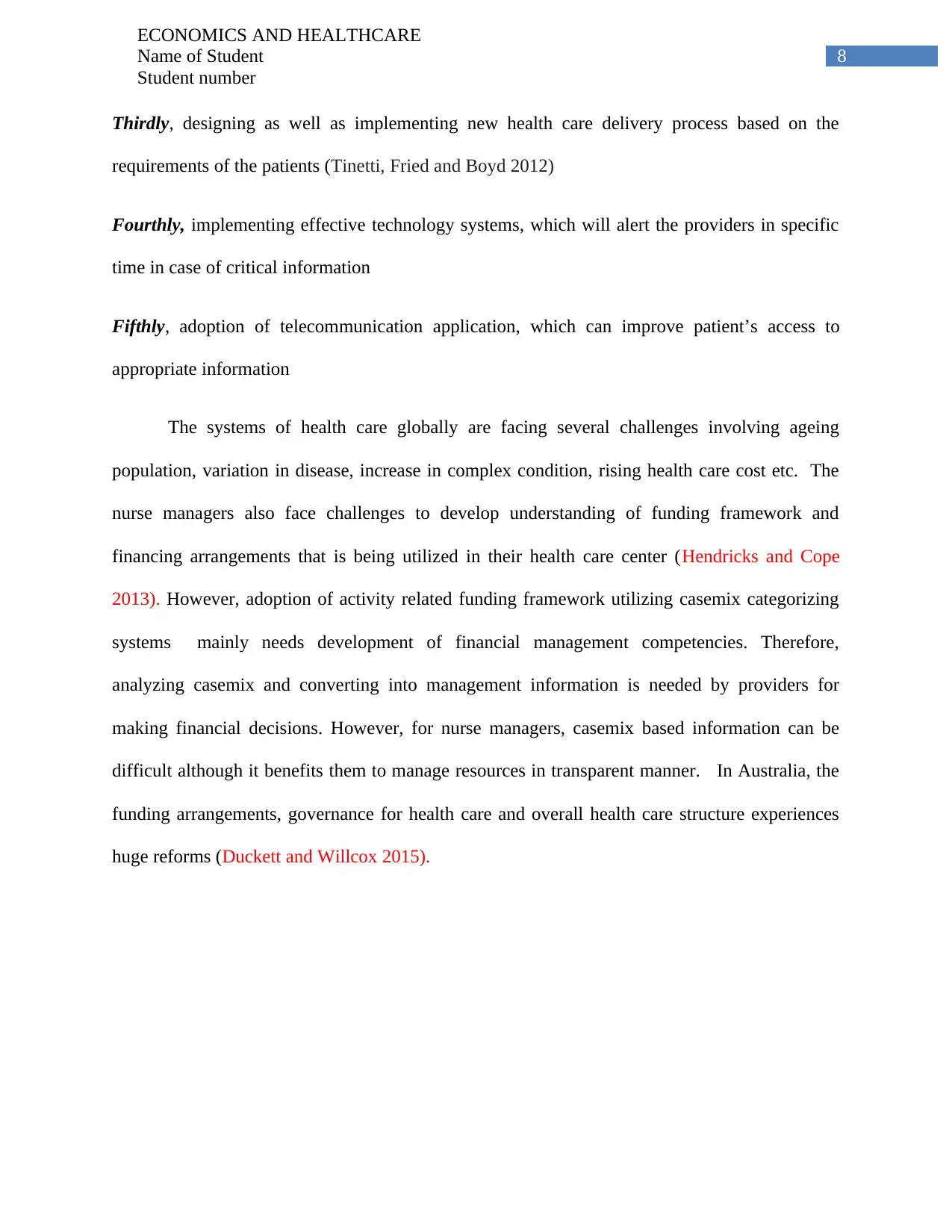
8
ECONOMICS AND HEALTHCARE
Name of Student
Student number
Thirdly, designing as well as implementing new health care delivery process based on the
requirements of the patients (Tinetti, Fried and Boyd 2012)
Fourthly, implementing effective technology systems, which will alert the providers in specific
time in case of critical information
Fifthly, adoption of telecommunication application, which can improve patient’s access to
appropriate information
The systems of health care globally are facing several challenges involving ageing
population, variation in disease, increase in complex condition, rising health care cost etc. The
nurse managers also face challenges to develop understanding of funding framework and
financing arrangements that is being utilized in their health care center (Hendricks and Cope
2013). However, adoption of activity related funding framework utilizing casemix categorizing
systems mainly needs development of financial management competencies. Therefore,
analyzing casemix and converting into management information is needed by providers for
making financial decisions. However, for nurse managers, casemix based information can be
difficult although it benefits them to manage resources in transparent manner. In Australia, the
funding arrangements, governance for health care and overall health care structure experiences
huge reforms (Duckett and Willcox 2015).
ECONOMICS AND HEALTHCARE
Name of Student
Student number
Thirdly, designing as well as implementing new health care delivery process based on the
requirements of the patients (Tinetti, Fried and Boyd 2012)
Fourthly, implementing effective technology systems, which will alert the providers in specific
time in case of critical information
Fifthly, adoption of telecommunication application, which can improve patient’s access to
appropriate information
The systems of health care globally are facing several challenges involving ageing
population, variation in disease, increase in complex condition, rising health care cost etc. The
nurse managers also face challenges to develop understanding of funding framework and
financing arrangements that is being utilized in their health care center (Hendricks and Cope
2013). However, adoption of activity related funding framework utilizing casemix categorizing
systems mainly needs development of financial management competencies. Therefore,
analyzing casemix and converting into management information is needed by providers for
making financial decisions. However, for nurse managers, casemix based information can be
difficult although it benefits them to manage resources in transparent manner. In Australia, the
funding arrangements, governance for health care and overall health care structure experiences
huge reforms (Duckett and Willcox 2015).
⊘ This is a preview!⊘
Do you want full access?
Subscribe today to unlock all pages.

Trusted by 1+ million students worldwide
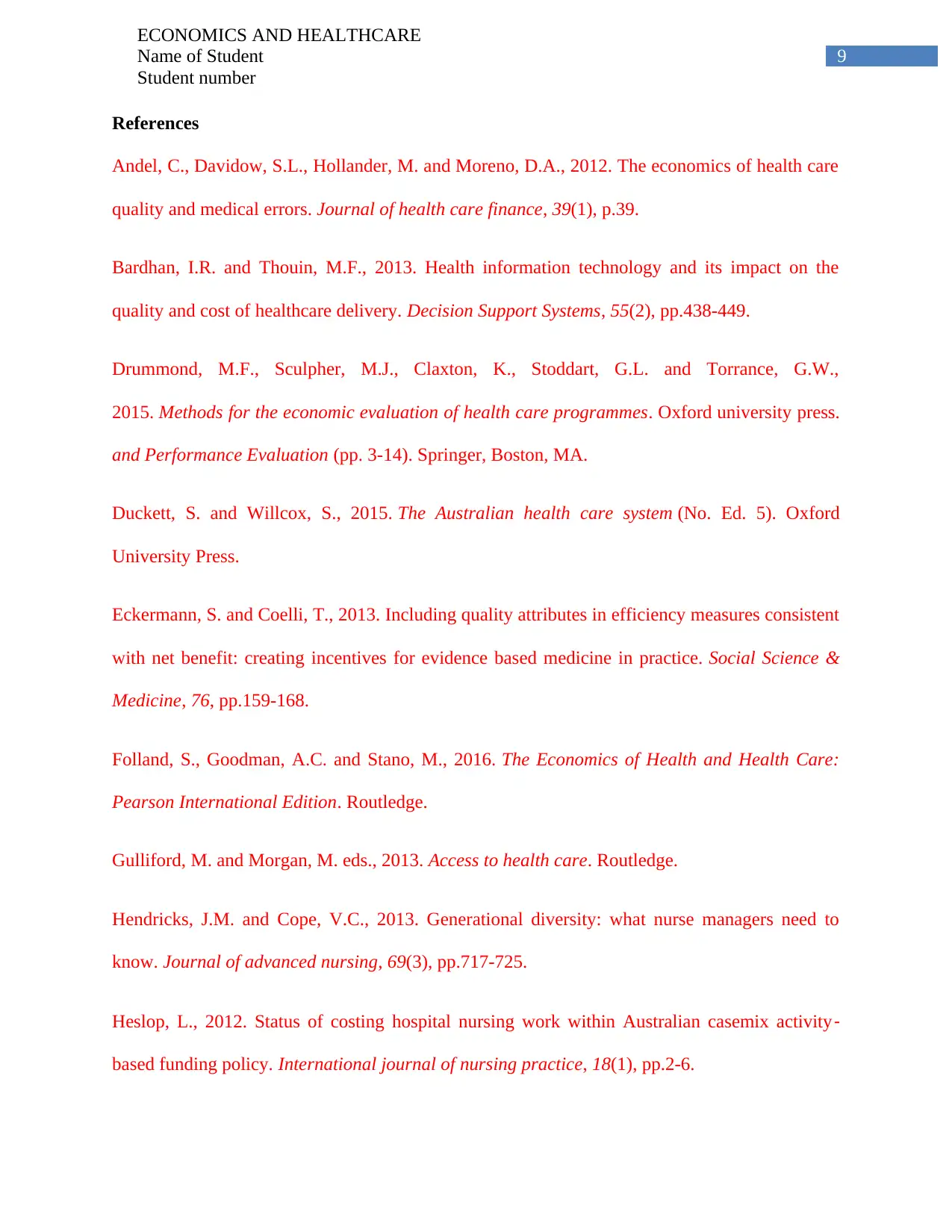
9
ECONOMICS AND HEALTHCARE
Name of Student
Student number
References
Andel, C., Davidow, S.L., Hollander, M. and Moreno, D.A., 2012. The economics of health care
quality and medical errors. Journal of health care finance, 39(1), p.39.
Bardhan, I.R. and Thouin, M.F., 2013. Health information technology and its impact on the
quality and cost of healthcare delivery. Decision Support Systems, 55(2), pp.438-449.
Drummond, M.F., Sculpher, M.J., Claxton, K., Stoddart, G.L. and Torrance, G.W.,
2015. Methods for the economic evaluation of health care programmes. Oxford university press.
and Performance Evaluation (pp. 3-14). Springer, Boston, MA.
Duckett, S. and Willcox, S., 2015. The Australian health care system (No. Ed. 5). Oxford
University Press.
Eckermann, S. and Coelli, T., 2013. Including quality attributes in efficiency measures consistent
with net benefit: creating incentives for evidence based medicine in practice. Social Science &
Medicine, 76, pp.159-168.
Folland, S., Goodman, A.C. and Stano, M., 2016. The Economics of Health and Health Care:
Pearson International Edition. Routledge.
Gulliford, M. and Morgan, M. eds., 2013. Access to health care. Routledge.
Hendricks, J.M. and Cope, V.C., 2013. Generational diversity: what nurse managers need to
know. Journal of advanced nursing, 69(3), pp.717-725.
Heslop, L., 2012. Status of costing hospital nursing work within Australian casemix activity‐
based funding policy. International journal of nursing practice, 18(1), pp.2-6.
ECONOMICS AND HEALTHCARE
Name of Student
Student number
References
Andel, C., Davidow, S.L., Hollander, M. and Moreno, D.A., 2012. The economics of health care
quality and medical errors. Journal of health care finance, 39(1), p.39.
Bardhan, I.R. and Thouin, M.F., 2013. Health information technology and its impact on the
quality and cost of healthcare delivery. Decision Support Systems, 55(2), pp.438-449.
Drummond, M.F., Sculpher, M.J., Claxton, K., Stoddart, G.L. and Torrance, G.W.,
2015. Methods for the economic evaluation of health care programmes. Oxford university press.
and Performance Evaluation (pp. 3-14). Springer, Boston, MA.
Duckett, S. and Willcox, S., 2015. The Australian health care system (No. Ed. 5). Oxford
University Press.
Eckermann, S. and Coelli, T., 2013. Including quality attributes in efficiency measures consistent
with net benefit: creating incentives for evidence based medicine in practice. Social Science &
Medicine, 76, pp.159-168.
Folland, S., Goodman, A.C. and Stano, M., 2016. The Economics of Health and Health Care:
Pearson International Edition. Routledge.
Gulliford, M. and Morgan, M. eds., 2013. Access to health care. Routledge.
Hendricks, J.M. and Cope, V.C., 2013. Generational diversity: what nurse managers need to
know. Journal of advanced nursing, 69(3), pp.717-725.
Heslop, L., 2012. Status of costing hospital nursing work within Australian casemix activity‐
based funding policy. International journal of nursing practice, 18(1), pp.2-6.
Paraphrase This Document
Need a fresh take? Get an instant paraphrase of this document with our AI Paraphraser
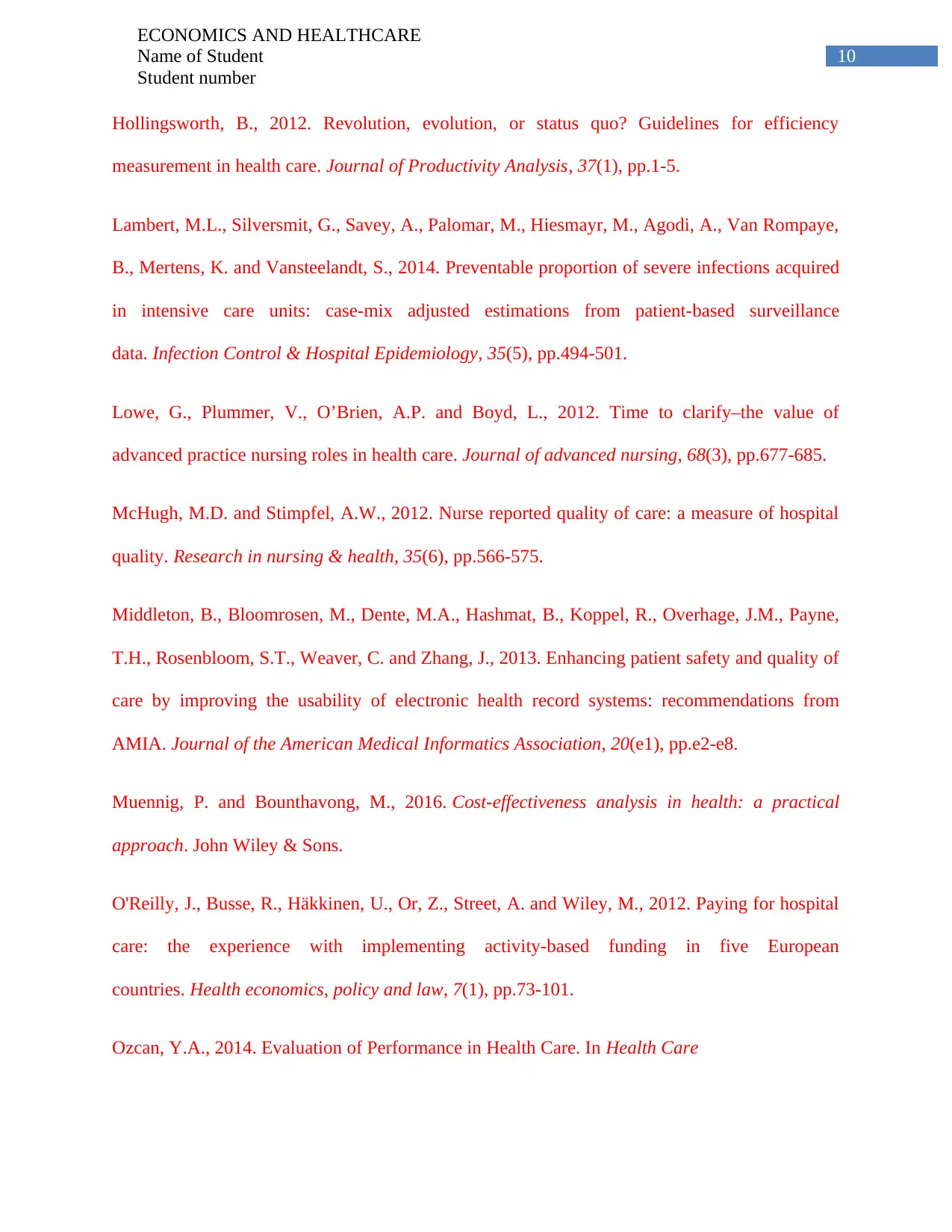
10
ECONOMICS AND HEALTHCARE
Name of Student
Student number
Hollingsworth, B., 2012. Revolution, evolution, or status quo? Guidelines for efficiency
measurement in health care. Journal of Productivity Analysis, 37(1), pp.1-5.
Lambert, M.L., Silversmit, G., Savey, A., Palomar, M., Hiesmayr, M., Agodi, A., Van Rompaye,
B., Mertens, K. and Vansteelandt, S., 2014. Preventable proportion of severe infections acquired
in intensive care units: case-mix adjusted estimations from patient-based surveillance
data. Infection Control & Hospital Epidemiology, 35(5), pp.494-501.
Lowe, G., Plummer, V., O’Brien, A.P. and Boyd, L., 2012. Time to clarify–the value of
advanced practice nursing roles in health care. Journal of advanced nursing, 68(3), pp.677-685.
McHugh, M.D. and Stimpfel, A.W., 2012. Nurse reported quality of care: a measure of hospital
quality. Research in nursing & health, 35(6), pp.566-575.
Middleton, B., Bloomrosen, M., Dente, M.A., Hashmat, B., Koppel, R., Overhage, J.M., Payne,
T.H., Rosenbloom, S.T., Weaver, C. and Zhang, J., 2013. Enhancing patient safety and quality of
care by improving the usability of electronic health record systems: recommendations from
AMIA. Journal of the American Medical Informatics Association, 20(e1), pp.e2-e8.
Muennig, P. and Bounthavong, M., 2016. Cost-effectiveness analysis in health: a practical
approach. John Wiley & Sons.
O'Reilly, J., Busse, R., Häkkinen, U., Or, Z., Street, A. and Wiley, M., 2012. Paying for hospital
care: the experience with implementing activity-based funding in five European
countries. Health economics, policy and law, 7(1), pp.73-101.
Ozcan, Y.A., 2014. Evaluation of Performance in Health Care. In Health Care
ECONOMICS AND HEALTHCARE
Name of Student
Student number
Hollingsworth, B., 2012. Revolution, evolution, or status quo? Guidelines for efficiency
measurement in health care. Journal of Productivity Analysis, 37(1), pp.1-5.
Lambert, M.L., Silversmit, G., Savey, A., Palomar, M., Hiesmayr, M., Agodi, A., Van Rompaye,
B., Mertens, K. and Vansteelandt, S., 2014. Preventable proportion of severe infections acquired
in intensive care units: case-mix adjusted estimations from patient-based surveillance
data. Infection Control & Hospital Epidemiology, 35(5), pp.494-501.
Lowe, G., Plummer, V., O’Brien, A.P. and Boyd, L., 2012. Time to clarify–the value of
advanced practice nursing roles in health care. Journal of advanced nursing, 68(3), pp.677-685.
McHugh, M.D. and Stimpfel, A.W., 2012. Nurse reported quality of care: a measure of hospital
quality. Research in nursing & health, 35(6), pp.566-575.
Middleton, B., Bloomrosen, M., Dente, M.A., Hashmat, B., Koppel, R., Overhage, J.M., Payne,
T.H., Rosenbloom, S.T., Weaver, C. and Zhang, J., 2013. Enhancing patient safety and quality of
care by improving the usability of electronic health record systems: recommendations from
AMIA. Journal of the American Medical Informatics Association, 20(e1), pp.e2-e8.
Muennig, P. and Bounthavong, M., 2016. Cost-effectiveness analysis in health: a practical
approach. John Wiley & Sons.
O'Reilly, J., Busse, R., Häkkinen, U., Or, Z., Street, A. and Wiley, M., 2012. Paying for hospital
care: the experience with implementing activity-based funding in five European
countries. Health economics, policy and law, 7(1), pp.73-101.
Ozcan, Y.A., 2014. Evaluation of Performance in Health Care. In Health Care
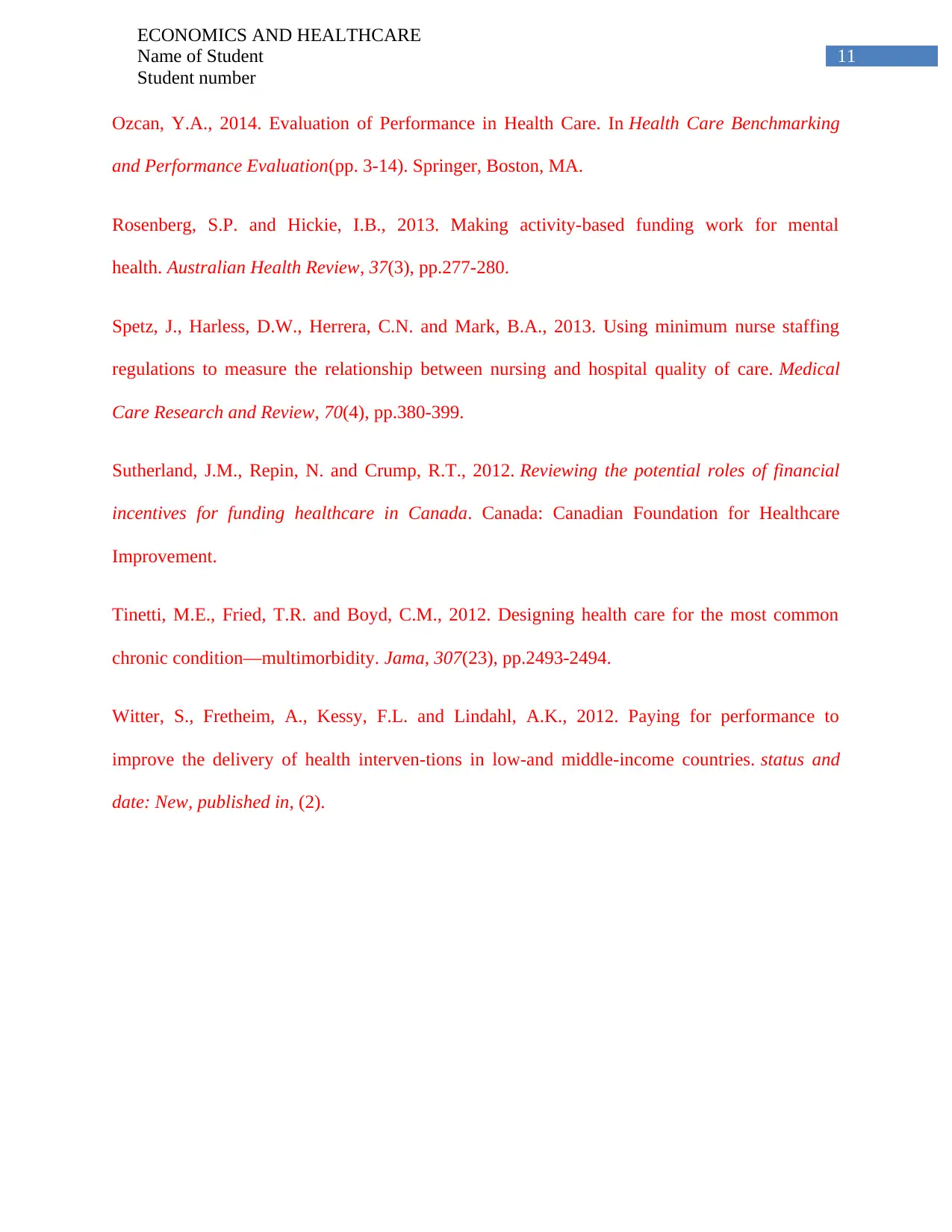
11
ECONOMICS AND HEALTHCARE
Name of Student
Student number
Ozcan, Y.A., 2014. Evaluation of Performance in Health Care. In Health Care Benchmarking
and Performance Evaluation(pp. 3-14). Springer, Boston, MA.
Rosenberg, S.P. and Hickie, I.B., 2013. Making activity-based funding work for mental
health. Australian Health Review, 37(3), pp.277-280.
Spetz, J., Harless, D.W., Herrera, C.N. and Mark, B.A., 2013. Using minimum nurse staffing
regulations to measure the relationship between nursing and hospital quality of care. Medical
Care Research and Review, 70(4), pp.380-399.
Sutherland, J.M., Repin, N. and Crump, R.T., 2012. Reviewing the potential roles of financial
incentives for funding healthcare in Canada. Canada: Canadian Foundation for Healthcare
Improvement.
Tinetti, M.E., Fried, T.R. and Boyd, C.M., 2012. Designing health care for the most common
chronic condition—multimorbidity. Jama, 307(23), pp.2493-2494.
Witter, S., Fretheim, A., Kessy, F.L. and Lindahl, A.K., 2012. Paying for performance to
improve the delivery of health interven-tions in low-and middle-income countries. status and
date: New, published in, (2).
ECONOMICS AND HEALTHCARE
Name of Student
Student number
Ozcan, Y.A., 2014. Evaluation of Performance in Health Care. In Health Care Benchmarking
and Performance Evaluation(pp. 3-14). Springer, Boston, MA.
Rosenberg, S.P. and Hickie, I.B., 2013. Making activity-based funding work for mental
health. Australian Health Review, 37(3), pp.277-280.
Spetz, J., Harless, D.W., Herrera, C.N. and Mark, B.A., 2013. Using minimum nurse staffing
regulations to measure the relationship between nursing and hospital quality of care. Medical
Care Research and Review, 70(4), pp.380-399.
Sutherland, J.M., Repin, N. and Crump, R.T., 2012. Reviewing the potential roles of financial
incentives for funding healthcare in Canada. Canada: Canadian Foundation for Healthcare
Improvement.
Tinetti, M.E., Fried, T.R. and Boyd, C.M., 2012. Designing health care for the most common
chronic condition—multimorbidity. Jama, 307(23), pp.2493-2494.
Witter, S., Fretheim, A., Kessy, F.L. and Lindahl, A.K., 2012. Paying for performance to
improve the delivery of health interven-tions in low-and middle-income countries. status and
date: New, published in, (2).
⊘ This is a preview!⊘
Do you want full access?
Subscribe today to unlock all pages.

Trusted by 1+ million students worldwide
1 out of 12
Related Documents
Your All-in-One AI-Powered Toolkit for Academic Success.
+13062052269
info@desklib.com
Available 24*7 on WhatsApp / Email
![[object Object]](/_next/static/media/star-bottom.7253800d.svg)
Unlock your academic potential
Copyright © 2020–2025 A2Z Services. All Rights Reserved. Developed and managed by ZUCOL.





